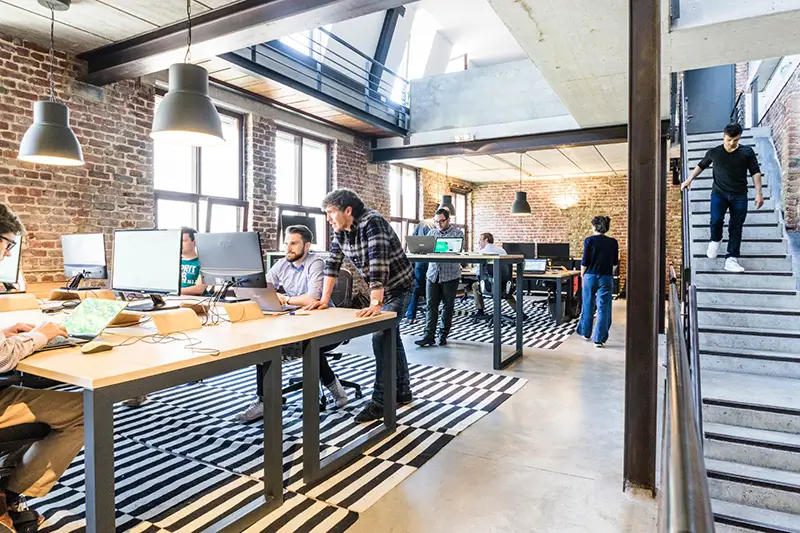Click here to get this post in PDF
Workplace safety is one of the biggest challenges of any business. Keeping the employees safe is a concern because accidents happen, whether it is a wet floor, slippery stairway, unorganized workspace, or more. Developing and maintaining a healthy and safe workplace ensures no injuries and accidents occurring. The scope of your healthy and safe workplace program depends on the size of your business and the hazards at your particular workspace. From inspecting your workplace to training your employees, investigating accidents, maintaining records, and keeping an open dialogue are some of the ways you can initiate a plan for a safe working environment for you and your employees.
With that said, in this post, we will discuss the top 7 tips for designing a smart and safe workspace.
#1 Install Stair Nosing
Stair safety is paramount to preventing injuries and accidents. The nose of the stair is where people usually put their feet, and it is the part that tends to wear out. This increases the risk of slips and falls for people. If your workplace is in an old building, you can secure the stairs with stair nosings. Stair nosings are metal strips, usually brass and aluminium, that are placed on the edge of the step, giving it anti-slip functionality.
With health becoming the top priority for people, they have started taking stairs instead of lifts at the workplace. So, there is an increased amount of pedestrian traffic on building stairs each day. This could result in wearing out the steps, making them prone to slips.
By simply adding aluminium or brass stair nosings can prevent slips and falls and add a sense of security. This not only helps people climb stairs but also enhances the longevity of the stairs. So, invest in good-quality stair nosings that are heavy-duty and specifically designed to prevent slips.
#2 Upgrade the Entrance Matting
We typically put commercial entrance matting to keep the shoes clean before entering the building. But they do more than this. Entrance matting plays a vital role in keeping the floor dry, especially when the weather is harsh. The entrance matting you get should cover the full width of the entry areas. Most importantly, they should be deep enough to ensure that all shoes are properly cleaned and dried once inside. Once in a while, the matting should be cleaned and serviced with pressure washing to relieve it from any dirt and debris.
#3 Put Tactile Ground Surface Indicators
TGSIs or tactile ground surface indicators are products made from various materials that are installed into the ground to give people warning or directional information and aid navigation. These indicators are commonly placed on moving walks, ramps, escalators, and stairways. They are designed to be attention-grabbing. So, when you are walking down the stairs in a hurry and see a sign that says ‘walk down slowly,’ you will automatically slow down.
#4 Train your Employees
Apart from installing safety products in the workplace, you must train your employees on how to protect themselves. Provide them with written instructions and safe work procedures. Encourage them to always maintain an organized and uncluttered workspace. In the case of operating complicated machines, the employees should be briefed before they are allowed to use them.
#5 Set and Follow Emergency Protocols
Usually, workplaces don’t do security drills. But this is a big mistake. Emergencies can come knocking at your door in the form of fire, flood, earthquake, flood, tornado, etc. So, everyone in your building must be prepared for everything that your region is prone to. Every month, plan a surprise emergency evacuation and drill to see how vigilant your employees are. Call in experts from the fire department and police department and ask them to give a presentation on how to conduct safe evacuation drills.
Using a wayfinding software is extremely helpful in mapping an office environment. This can help your employees and even your visitors find their way around your building. This is especially helpful during emergencies and when the building has a complex design.
#6 Reduce Workplace Stress
Oftentimes, people under work pressure or facing deadlines can’t think straight. They tend to move fast in a hurry and may end up slipping, tripping, or falling. Job stress can lead to workplace accidents, burnout, health problems, and more. So, as an employer, you must identify any threats and risks that your employees can be exposed to. Take necessary actions to reduce the stress that can interfere with the employee’s well-being and productivity.
#7 Investigate Accidents
You are advised to investigate accidents, irrespective of whether they resulted in a serious injury. It will help you in determining the reason why the incident happened in the first place. This way, you can take the necessary steps to ensure such accidents don’t happen in the future.
The need for good planning and design for public and commercial spaces is prominent to prevent accidents. It is important that you conduct audits and consult with experts to determine how to make your workplace safer.
You may also like: 6 Office Designs That Will Boost Productivity
Image source: Unsplash.com

